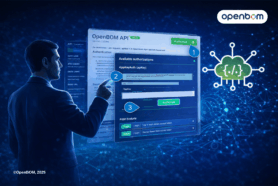
The world of engineering design and product development is changing. The CAD and PLM industry is undergoing a transformative shift. Historically, CAD data were presented as documents, first 2D drawings, and later 3D CAD models that described the product, geometry, and any additional information about manufacturing and assembly. Legacy PDM/PLM systems focused on how to combine these documents with all revisions in a single source of truth to control the files with associated metadata. That created large legacy systems of records focusing on how to control all data and documents in a single database.
These legacy systems manage data structures (usually design BOMs) with metadata and documents connected to these records. The core function of these systems is engineering change management, which is basically a “release process”.
Here is how it is going to change very soon. The trend is towards data-driven systems that are transforming the way companies work with these documents and data. The document records will evolve into data records and a network of connected objects representing an entire product data set and their relationships. As we transition from CAD documents to a data-centric paradigm, the potential for real-time insights, adaptability, and enhanced collaboration becomes boundless.
As Jos Voskuil wrote in his recent article Do the big PLM players need to change their strategy?, PLM is no longer a single system, but a strategy requires implementing multiple systems:
The most significant change I noticed in my discussions is the growing awareness that PLM is no longer covered by a single system. More and more, PLM is considered a strategy, with which I fully agree. Therefore, implementing a PLM strategy requires holistic thinking and an infrastructure of different types of systems, where possible, digitally connected. This trend is bad news for the PLM vendors as they continuously work on an end-to-end portfolio where every aspect of the PLM lifecycle is covered by one of their systems. The company’s IT department often supports the PLM vendors, as IT does not like a diverse landscape.
Here is how this trend is impacting PLM solutions and software. The traditional system is described as a set of records that focus on traceable data sets, but they are not focused on collaboration, ease of change, and contextual communication between users and systems.
Instead of that here is the future picture Jos outlined in his article:
- We are not talking about a PLM system anymore; a traditional System of Record will be digitally connected to different Systems of Engagement / Domains / Products, which have their own optimized environment for real-time collaboration.
- The BOM structures remain essential for the hardware part; however, overreaching structures are needed to manage software and hardware releases for a product. These structures depend on connected datasets.
- To support digital twins at the various lifecycle stages (design. Manufacturing, operations), product data needs to be based on and consumed by models.
- A future PLM infrastructure is hybrid, based on a Single Source of Change (SSoC) and an Authoritative Source of Truth (ASoT) instead of a Single Source of Truth (SSoT).
At OpenBOM we build a new approach how to support this new connected world with our unique technology.
OpenBOM Data Architecture of Digital Thread and Data Network
While old product lifecycle management software was designed as a single database for one company, OpenBOM architecture is different and focused on how to build a connected data set capable of covering various disciplines of product data management. The foundation of the system is not a set of documents connected into a BOM structure, but a digital data set (a graph of information) semantically connected to support multiple data records.
Here is a high-level data architecture of OpenBOM:
The underlying data architecture of the OpenBOM platform is a set of connected business objects. While OpenBOM provides a set of out-of-the-box business objects (catalogs, BOMs, orders, vendors, etc.), the foundation of the platform is flexible and allows the customer to build custom objects. Here is an example of a more granular set of information.
And here are examples of different custom objects you can build using OpenBOM.
Design Digital Thread and Step Beyond CAD Documents
The implications of the data network approach supported by OpenBOM are big if you think about how to apply the same model to complex multi-disciplinary design digital threads. Each product has multiple design aspects – mechanical, electronics, and software. Companies are using multiple design systems to make it happen. But the outcome of these systems are documents that cannot be really easily connected together. Also, from a consumption standpoint, especially downstream, companies are looking at how to provide access to a specific subset of data (eg. sheet metal part, electronic sub-system or software code)., instead of getting an entire data set.
OpenBOM helps companies extract valuable data and make it available based on the needs of the design team or specific contractors.
Here is how it looks from an OpenBOM data architecture standpoint:
System of Engagement and Collaboration
The modern approach of data networks plays a big role in the transformations of the design process and the way systems can be used to streamline collaboration. Legacy Product Lifecycle Management (PLM) software is not user-friendly and often overwhelming for customers (especially outside of engineering, but not only). Different design engineers, production planners, and other users don’t like the way these systems give them access to information.
Instead, the collaborative approach offered by OpenBOM is different and appealing to many customers. Think about a complex multi-disciplinary Bill of Materials that can be extracted from SOR (systems of records) and design systems to become available for the team focusing on changes, contractor work, or specific subsystems.
OpenBOM’s unique patented BOM collaboration approach allows you to get the live data set from different systems and to allow users to communicate in real-time, discuss changes, make impact analysis, and submit results synchronized to systems of records.
Conclusion:
The modern product development process requires taking steps beyond traditional document management and single PLM database to improve computer-aided design, supply chain management, and manufacturing processes for the entire product lifecycle. Companies are looking into strategies and technologies that allow them to transform product lifecycle management from single siloed systems to a connected set of business systems capable of interplaying together and providing real-time data access to a specific set of information in the contextual form. It will benefit business processes and process management in general but also provide the right information to the right people at the right time.
The future belongs to data networks capable of providing access information across the entire product lifecycle including computer-aided design, production process planning, and supply chain management.
Interested to talk more about data management and product transformation?
SCHEDULE A MEETING and we would be happy to discuss your data strategy.
Meantime, REGISTER FOR FREE and start a 14-day trial to learn more.
Best, Oleg
Join our newsletter to receive a weekly portion of news, articles, and tips about OpenBOM and our community.











